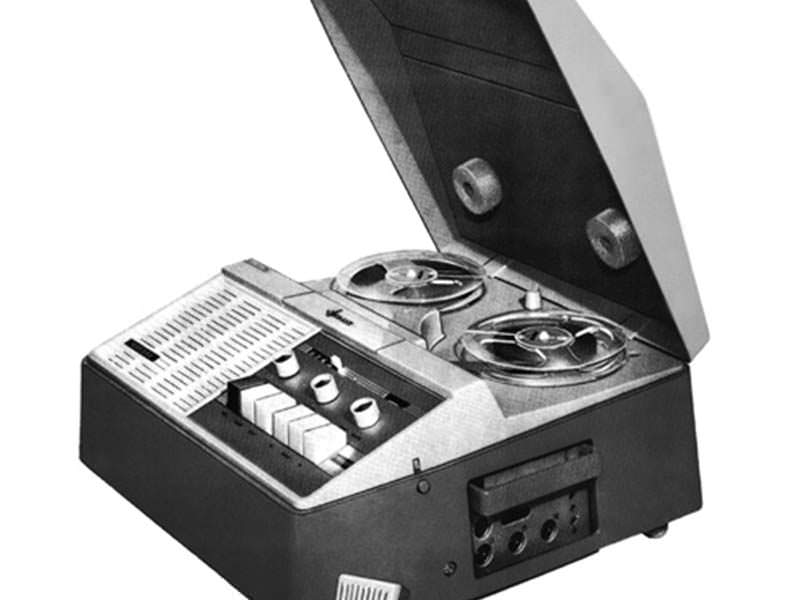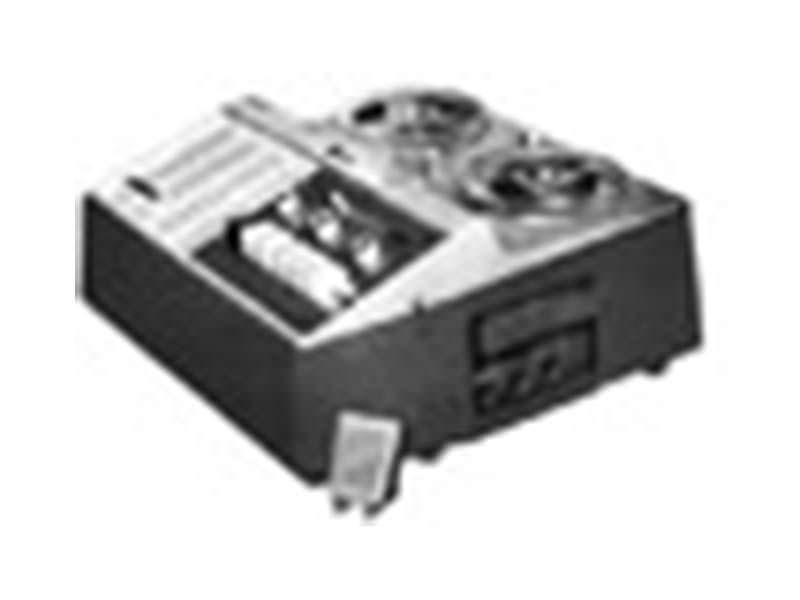Technical Details
Brand: Cossor
Model:CR-1604
Category:Mid High Fidelity
Application:Consumer
Electronics:Solid State
Country of Manufacture:United Kingdom
Release dates:1963 - 1966
Tracks:1/4 Rec/PB
Speeds: 1 7/8, 3 3/4
Max Reel Size("): 3"
Number of heads: 2
Head Composition: Permalloy
Head Configuration: Mono - Full Track
Frequency Response:(all 3 dB): 3¾ ips: 60 - 13kHz
Wow and Flutter:below 0.08% at 3¾ ips, below 0.1% at 1ips
Signal-to-Noise Ratio:better than 40 dB
Sound quality rating:5 / 10
Long-term reliability rating: 5/ 10
Additional Details
Description
This quarter-track mono recorder was actually manufactured by the Austrian company Stella and sold by Cossor Radio and Television Limited, 233 Tottenham Court Road, London,
W.1. It was a well-equipped and practical machine with facilities for stereo playback (using Cossor’s external pre-amplifier EL3587). “Duo-play” and “Multi-play”
were also possible with this amplifier. Other features included parallel-playback, mixing of
low and high-level inputs and the internal 3-watt amplifier could be used in straight-through mode. Wow and flutter were exceptionally good, especially on the slow speed of 1 7/8ips.
Audio output power: 3 watts / Fast wind: 1,800 ft. in three minutes / Inputs: diode 20K, 3 mV. gram 500 K, 150 mV. microphone, 1 K, 1 mV / Outputs: diode, 20 K, 1V. loudspeaker, 3-7 ohms, 2.2W. headphones, 1.5 K, 200 mV. stereo, 300 ohms, 0.4 mV at 1Kc / s. / Valve complememnt: ECL82, EM87, five transistors, a diode and a selenium rectifer / Speaker(s): 6½ inch internal speaker / Dimensions: 14½ x 14½ x 7¼ ins (368 x 368 x 184 mm) / Weight: 18 lbs (8.2 kg) / quarter track mono
Additional Info
Taken from The Tape Recorder, March 1964
Manufacturer’s Specification:
Recording Sense: ¼-track. Tape speeds: 3¾ and 1 i/s. Mains voltages: (Adjustable), 110, 127, and 200-250V AC 50 c/s. (Can be adapted for 60 C/S.) Facilities: “Stereo” output socket, for reproduction of pre-recorded stereo tapes in conjunction with EL 3587 pre-amplifier. “Duo-play” and “Multi-play” also possible with this amplifier. Parallel-playback. Mixing of low and high-level inputs. Can be used as straight-through amplifier. Spool capacity: Up to 7 inches. Frequency response: 1 i/s: 60 c/s to 10 Kc/s ±3 dB, 3¾ i/s : 60 c/s to 13 Kc/s ±3 dB. Fast wind: 1,800 ft. in three minutes. Power consumption: 50W. Signal-to-noise ratio: better than 40 dB. Inputs: (1) diode 20K, 3 mV; (2) gram 500 K, 150 mV; (3) microphone, 1 K, 1 mV. Outputs: (1) diode, 20 K, 1V; (2) Loudspeaker, 3-7 ohms, 2.2W;(3 ) headphones, 1.5 K, 200 mV; (4) stereo, 300 ohms, 0.4 mV at 1Kc/s. Dimensions: 14½ x 14½ x 7¼ ins. Weight: 18 lbs. “Tropicalised”. Price: £40 19s. Manufacturer: Cossor Radio and Television Limited, 233 Tottenham Court Road, London, W.1.
THIS machine uses a hybrid circuit with transistors for all low-level stages and with a 3W pentode for the output stage, thus making the best of both worlds: low hum and noise in all recording and playback circuits and more power output than can easily be obtained from transistors. The valve output stage remains in circuit when recording, so that monitoring at full level is possible whilst recording from radio or gramophone, and at reduced level-to avoid acoustic “howl back’—when recording from microphone. The centre volume control sets playback and monitoring level only. Separate controls for radio/gramophone and microphone are provided so that these signals can be mixed while recording. The right-hand microphone control becomes the tone control on playback.
The loudspeaker faces upwards so that the operator is on the axis for really critical listening when setting the controls or playing back a recording. This placement of the speaker also provides a more favourable baffle area and avoids the mid-frequency “boxiness” so common in compact table model recorders.
Wow and Flutter
The drive to the flywheel is by a simple round cross-section belt, with a very elegant speed change “switch” which moves the belt from one pulley diameter to the other on the motor shaft.
The “fluttergrams” of fig. 1 show that wow and flutter provide almost equal contributions to the total speed imperfections shown in the pen recordings. Wow, due to capstan or flywheel eccentricity, is just perceptible at 2 c/s at 3¾ i/s and 1 c/s at 1 i/s.
The high frequency flutter is a mixture of 100 c/s pulsating torque as the motor armature moves from pole to pole, and 50 c/s which is the motor spindle rotation frequency. At the higher speed the smoothing effect of the flywheel is at a maximum so that the 100 c/s flutter is lost and only a very small amount of 50 c/s is left. At the lower speed all three effects can be observed. Despite this, the music quality on 1 i/s is as good as anything I have heard on very much more expensive and elaborate machines.
Play-only Tests
Fig. 2 shows the play-only responses from test tapes recorded to surface induction characteristics of 200 and 400 micro-seconds respectively. Both show the mid frequency step which indicates that the playback equalisation is to the Continental 100 and 200 micro-second time constants.
System noise and hum, with no tape running, was extremely low at 35 dB below test-tape level or 47 dB below theoretical peak recording level.
Record-play Tests
Oscillator tones were fed to the radio/gramophone input and the playback level measured at the radio or diode line output. These responses for the two speeds are shown in fig. 3.
The responses of the top and bottom tracks were so nearly identical that it was not worth plotting them separately.
Peak recording level at 12 dB above test-tape level was recorded with the magic-eye beams just touching with negligible waveform distortion. Recorded noise, due to bias and erase, was 43 dB below peak recording level. Bulk erased tape noise was 45 dB below peak, showing that bias and erase noise was at a very low level. At this point I did notice that, as the microphone control doubles as a playback tone control, there is a tendency to leave this control fully advanced for maximum top response which leaves the microphone channel wide open when recording from radio. Such a procedure will add 3 to 4 dB of hiss to any radio or record recordings. One way of avoiding this mistake is to leave the microphone plugged in, when the ear-splitting screech on switching to record will soon remind you to turn the control to zero while recording from radio or gramophone.
Acoustic Response
One-third octave bands of filtered white-noise were recorded at 3¾ i/s and the sound output of the speaker measured on axis by a calibrated microphone during replay. The resultant electro-acoustic response is shown by fig. 4. The solid curve is with the tone control fully advanced, and the dotted curve shows the effect of maximum top cut. The slight fall in response at high frequencies, even with the tone control at maximum, is compensated to some extent by the fact that the natural listening position is on the axis of the speaker.
Microphone Response
The microphone response was measured in a white-noise sound field to give the response shown in fig. 5. The response would sound thin and lacking in bass on a really wide-range sound system, but reference to fig. 4 above will show that it matches the acoustic .response of the recorder very closely, and further extension of the response would not be very noticeable. Speech quality is crisp and clean and the cut in bass response covers up a number of room effects which would be obvious on a wider range instrument.
Comment
“Top of the class” for this little machine. In its class, as a medium priced domestic recorder, I cannot fault it.
Its electrical response on both speeds is smooth and well balanced. The signal/noise ratio is excellent. Mechanical noise is low. Controls are well placed and simple to operate. Sound quality is “big” and open due to the well placed efficient speaker and output stage. The built-in mixer and parallel mixing of the two tracks, together with the added facilities provided by making the output of second head available for stereo playback or cross recording from track to track (via EL3787 pre-amp), makes this a recorder for the cine or documentary tape enthusiast as well as for the
most non-technical member of the family.
A. Tutchings.



